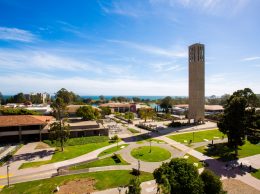
Henry Dubroff
Spring is the time for commencement ceremonies and self-congratulation.
But this year is no time for celebration when it comes to California’s public universities. A new report from the California Budget Project underscores how poorly voters, bureaucrats and elected officials have managed the state’s signature assets. And how persistent failure to fairly allocate funding has shifted the burden of higher education onto the shoulders of students and their families.
For the past three decades, public university funding has fallen 13 percent in inflation-adjusted dollars while enrollment has risen 50 percent, roughly half the rate of population growth. Meanwhile, the report says, tuition and fees have skyrocketed from $1,376 to $5,472 a year at California State University campuses and from $2,865 to $12,192 at the University of California system.
As a member of the CSU Channel Islands Foundation board, I’ve seen the direct impact of this mismanagement in the Ventura-Santa Barbara-North Los Angeles County area we are supposed to serve. CSUCI was built to be a high-tech, pioneering effort to provide education to a diverse population, including the large number of Hispanic students, many of them farmworker’s children, who reside in the area.
For much of the past decade, CSUCI has lived under a draconian regime of enrollment caps that were the direct result of funding shortfalls. Only heroic efforts by university President Dick Rush kept the Camarillo campus from losing students and it is only now clawing its way back toward a decade-long goal of 15,000 undergraduate enrollments.
UC Santa Barbara and Cal Poly San Luis Obispo are increasingly filling their budget holes by accepting more foreign and out-of-state students, who pay mucher higher tuition. And as the CBP report shows, in-state undergraduates are graduating with average debt loads of between $15,000 and $20,000.
Gov. Jerry Brown’s proposed budget for the new fiscal year includes an additional $142 million for each system, but that’s more of a band-aid than a long-term fix.
To truly fix California’s ailing university system will take a serious rethink of both the way it is funded and how it operates. Here are a few thoughts:
• Putting private capital to work for public university expansion is a path to success. For capital-hungry campuses such as CSUCI, and to a lesser extent UCSB and Cal Poly, waiting in a long line for public funding is not a viable option. Getting fast-track authority for public-private partnerships is going to be the key to growth.
• Pension reforms at both the state and university levels must be on the table. Reducing the amount of money that gets tied up in pensions is the only way to truly find funding for the future of the university system for the long haul. That means public-sector unions giving ground on retirement costs in order to let campuses like CSUCI grow and add new jobs.
• The private sector will have to do its part, particularly when it comes to scholarship funding, to keep a lid on student loans. The well-established efforts at the Scholarship Foundation of Santa Barbara and Ventura County Community Foundation will have to be greatly expanded to meet future needs.
• Vigorous and community-minded leadership at the campus level will be required to both create new opportunities for graduates and to keep the private sector engaged. Jeffrey Armstrong at Cal Poly has been most impressive in re-connecting his campus to the San Luis Obispo community.
The bottom line on the current crisis in higher education funding is that a new generation of college-bound Hispanic high-school graduates is really getting the short end of the stick. It’s particularly distressing because this generation, as with many of our own parents, often consists of the first members of a family with the ability to go to college. Immigration reform will not solve this problem but it will instead place a lot more financial pressure on CSU and UC enrollments.
The state needs more growth-oriented policies so it can grow the economic pie for all and provide funding for higher education. And it needs to rethink how many new programs and new regulations it can afford without choking off more opportunity.
Gov. Brown is on to this problem, and his budget plans are a signal that he’s keen to make a reshaping of the CSU and UC systems a part of his legacy. The bitter fight over Prop. 30 tax increases gave him some cash to put into the system but it is really only a down payment on a much larger fix.
• Contact Henry Dubroff at hdubroff@pacbiztimes.com.






 Print
Print Email
Email
















